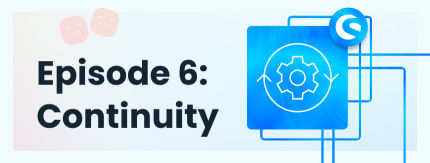
As the name suggests, our blog series on the “Customer Happiness Circle” is all about customers and how to make them even happier. In this post, customer happiness expert Johannes Altmann tells us what we need to do to stay focused on customer happiness.
“Out of sight, out of mind” might be an old saying, but it perfectly sums up the daily life of an ecommerce company. A customer you never see is quickly forgotten, which is why it’s so difficult to maintain customer focus over time.
So, in this final episode of the Customer Happiness Circle, we’ll look at how to keep the love you have for your customers alive. How can I organize myself and my company so that lofty goals like “We make our customers happy” remain top of mind?
To keep improving is a constant challenge
Many years ago, I read a fascinating book on the continual improvement process (CIP), the brainchild of a Japanese professor, Kaoru Ishikawa. In the 1950s, Ishikawa pioneered the use of quality management methods in Japanese industry. He recognized that continual improvement of working processes and products was necessary for long-term success. His method sounds simple enough, but it’s a big challenge for companies. The basic idea is to constantly analyze and improve processes and products, involving employees along the way.
I have never come across an ecommerce company that has an effective process for continual optimization in place. I can think of a couple of stores that run ongoing A/B tests, but that’s really only half the story. Customer happiness encompasses a whole lot more.
Understanding customer expectations and fulfilling them – or even going above and beyond.
Customers have often asked me – and rightly so – how they can align this with the release schedule for their online store. I used a Kano analysis to help me, because it’s the perfect way to find an answer to that question.
Kano analysis
The Kano model is a way of analyzing and evaluating customer needs and expectations. It was developed by a Japanese professor, Noriaki Kano, in the 1980s.
The Kano model is based on the principle that product features have different levels of importance for customers, and that there are different types of customer needs. The Kano model differentiates between three types of features:
1) Must-be features
These are features your customer expects and considers to be a given. If they don’t exist, customers are dissatisfied. For instance, a missing feature can make an online store seem considerably less attractive. By providing a must-be feature, what you are doing is simply meeting the basic requirements – there’s nothing missing, but your customers certainly won’t be jumping for joy, either.
2) Performance features
These are features that increase customer satisfaction when they’re included, and make customers less happy when they’re not. This is where you’ll find most of the usability principles. Good descriptions, good images, a store with a simple layout and fast service, etc. The better these features are, the more satisfied your customers will be.
3) Attractive features
These are features that customers often don’t know they want until they see them. Things that make their eyes light up and boost customer satisfaction. We’ve come up with digital consultants, gift registry functions, online product samples, and lots more for various projects. These are all functions that our customers have loved.
The Internet is full of Kano analysis templates, but you still need to consider a few more things, which brings us back to continuity.
Usability
I recommend that you assess the usability of your store on a regular basis. Book usability analyses, run user tests, or organize a regular review night with your staff where you look at the store together and search for errors and inconsistencies. The important thing is to always keep cognitive ease in mind.

Experience
Improving the customer experience is a bit more difficult. You need to know your customers’ expectations and want to exceed them. To do that, you’ll need customer insights, creativity, and a new way of looking at your customers. Then you can challenge the status quo and initiate new approaches.

Attractiveness
A Kano analysis will show you which ideas go beyond your basic goal and could really wow your customers. Companies need to keep delighting customers by making themselves attractive. And the only way to do that is to keep coming up with fresh ideas.

Personas
Personas are a way to sort and store your insights. Think of them as a chest of drawers. You’re always gaining new insights. Add them to your persona drawers. It’s an active system that you and your team should be using and adding to all the time.

Touchpoints
Every year, the number of touchpoints increases by 20%. So what you need to do is analyze your touchpoints annually, find new ones, and then evaluate and optimize them.

Conclusion
Establishing customer-centricity in your company opens up a whole new world. It’s fun when you go beyond talking about your product or service and start talking about your customers. Getting to know them better allows you to optimize and improve your offering.
All the best with your happy customers!

All episodes at a glance
Episode 0 – Introduction: Customer Happiness expert Johannes Altmann explains why the subject is so important and outlines the building blocks you can use to inspire your customers.
Episode 1 – Usability: find out how usability errors come about, how you can avoid them, and what impact good usability has on your users’ enjoyment of your store.
Episode 2 – Experience: this episode reveals what impacts customers and offers you inspiration to conjure up an unforgettable shopping experience.
Episode 3 – Brand belonging and your online store: in this episode, you'll learn how to make your online store your customers' favorite and create brand belonging.
Episode 4 – Touchpoints: episode four is about touchpoints of your brand that your customers interact with.
Episode 5 – Cluster costumers: what types of systems exist, how can they benefit you, and how can you utilize customer clusters to accurately depict your customers and their needs?
Episode 6 – Continuity: discover how to organize your business to ensure 'We make the customer happy' isn't a fleeting goal, but rather a constant focus on your agenda.










